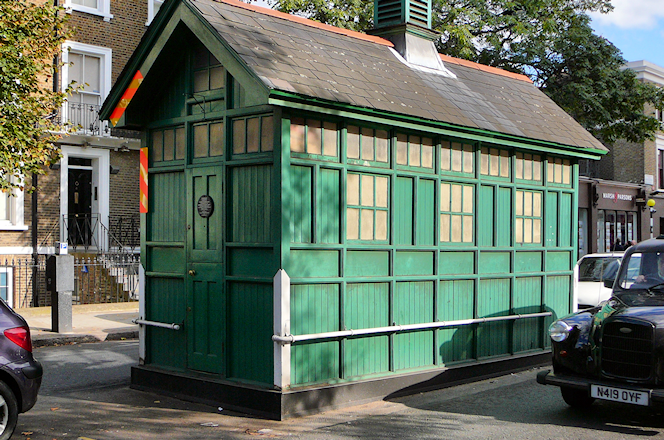Cabmen’s shelters
Cabmen’s shelters
Cabmen’s shelters are green-painted roadside sheds surviving at 13 locations in central London. Sir George Armstrong established the Cabmen’s Shelter Fund in 1875 to provide Hackney carriage drivers with a refuge where they could get a hot meal and a cup of tea, but strictly no alcohol. Similar facilities had previously been introduced in Edinburgh and Birmingham. Sixty-one such structures were erected in the capital, many individually endowed by a local philanthropist, who would also benefit from the improved availability of cabs, and more sober drivers.
Depending largely on the area in which they were located, the quality of the establishment could range from sordid to almost luxurious. Many of the shelters had nicknames, like the Bell and Horns at Thurloe Place, South Kensington; the Nursery End, near Lord’s; and the Junior Turf Club, on Piccadilly. The latter nickname was said to derive from an invading clientele of aristocratic champagne drinkers in the 1920s.
A visitor to the Westbourne Grove shelter in September 1888, calling himself ‘Dr J. Duncan’, was said to have confessed to the Jack the Ripper murders. The explorer Sir Ernest Shackleton was a regular at the Hyde Park Corner shelter, while the artist John Singer Sargent used the one near the Ritz. In the 1890s bohemian poets like Ernest Dowson treated their local shelters as a second home:
“They [young poets] used them as night-clubs, and retired to them at four o’clock in the morning for eggs-and-bacon. Not because they wanted eggs-and-bacon at four o’clock in the morning, but because the bourgeois did not eat eggs-and-bacon in cabmen’s shelters at four o’clock in the morning.”
Thomas Burke: London in My Time (1934)
Most shelters nowadays open only from breakfast to lunchtime and enforce a ‘cabbies only’ rule at the tables inside; several also provide a takeaway service from a window.


